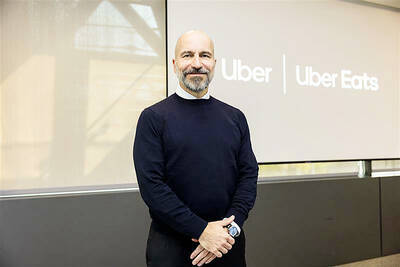China might focus more on domestic demand and reduce its reliance on exports to drive its economy in the post-COVID-19 era, which would affect Taiwan and South Korea the most, Australia and New Zealand Banking Group (ANZ) said on Friday.
China, which absorbs more than 40 percent of Taiwanese exports, might follow a domestic-focused growth path following the COVID-19 pandemic due to lingering trade tensions with the US and mounting deglobalization risks, ANZ said.
China’s GDP last quarter contracted 6.8 percent, with all components — including net exports — tumbling, because of drastic lockdowns and other measures to contain the virus, it said.
Its economic growth has slowed from a peak of 10 percent in 2012 to 6.2 percent last year, ANZ said.
The contribution of consumption and investments has lost traction over the past decade, while a reduced reliance on exports to drive growth also grew conspicuous, it said.
Although exports surprisingly gained 3.5 percent year-on-year last month on the back of electronics sales, uncertainty is rising amid renewed tariff threats from the US, ANZ said.
More than half of China’s imports — mostly high-tech goods — come from Taiwan, South Korea, the Philippines and Malaysia, it said.
These economies form the pillars of the electronics supply chain across Asia and play a pivotal role in China’s goal toward technology-driven growth, it said.
A structural policy change would have profound implications for major trade partners and the effects would be evident in the next two to three years, ANZ said.
The economies with close trade links to China are the most vulnerable: Taiwan and South Korea, it said.
Their exports are highly reliant on China, reflecting their deeply integrated parts in regional supply chains, especially in the electronics sector, ANZ said.
China last month accounted for 44.4 percent of Taiwanese exports, while markets elsewhere took a hit from the pandemic, according to Ministry of Finance data.
Supply chains in Asia are tightly interconnected, making individual economies interdependent on one another, and they revolve around China, a major trading partner for almost all of them, it said.
In the short term, these economies would continue to play disproportionately large roles in China’s growth aspirations, ANZ said.
In addition, they are well-placed to reap positive spillover effects from China’s foray into new sectors, such as technology and 5G, it said.

CHIP RACE: Three years of overbroad export controls drove foreign competitors to pursue their own AI chips, and ‘cost US taxpayers billions of dollars,’ Nvidia said China has figured out the US strategy for allowing it to buy Nvidia Corp’s H200s and is rejecting the artificial intelligence (AI) chip in favor of domestically developed semiconductors, White House AI adviser David Sacks said, citing news reports. US President Donald Trump on Monday said that he would allow shipments of Nvidia’s H200 chips to China, part of an administration effort backed by Sacks to challenge Chinese tech champions such as Huawei Technologies Co (華為) by bringing US competition to their home market. On Friday, Sacks signaled that he was uncertain about whether that approach would work. “They’re rejecting our chips,” Sacks

NATIONAL SECURITY: Intel’s testing of ACM tools despite US government control ‘highlights egregious gaps in US technology protection policies,’ a former official said Chipmaker Intel Corp has tested chipmaking tools this year from a toolmaker with deep roots in China and two overseas units that were targeted by US sanctions, according to two sources with direct knowledge of the matter. Intel, which fended off calls for its CEO’s resignation from US President Donald Trump in August over his alleged ties to China, got the tools from ACM Research Inc, a Fremont, California-based producer of chipmaking equipment. Two of ACM’s units, based in Shanghai and South Korea, were among a number of firms barred last year from receiving US technology over claims they have

It is challenging to build infrastructure in much of Europe. Constrained budgets and polarized politics tend to undermine long-term projects, forcing officials to react to emergencies rather than plan for the future. Not in Austria. Today, the country is to officially open its Koralmbahn tunnel, the 5.9 billion euro (US$6.9 billion) centerpiece of a groundbreaking new railway that will eventually run from Poland’s Baltic coast to the Adriatic Sea, transforming travel within Austria and positioning the Alpine nation at the forefront of logistics in Europe. “It is Austria’s biggest socio-economic experiment in over a century,” said Eric Kirschner, an economist at Graz-based Joanneum

OPTION: Uber said it could provide higher pay for batch trips, if incentives for batching is not removed entirely, as the latter would force it to pass on the costs to consumers Uber Technologies Inc yesterday warned that proposed restrictions on batching orders and minimum wages could prompt a NT$20 delivery fee increase in Taiwan, as lower efficiency would drive up costs. Uber CEO Dara Khosrowshahi made the remarks yesterday during his visit to Taiwan. He is on a multileg trip to the region, which includes stops in South Korea and Japan. His visit coincided the release last month of the Ministry of Labor’s draft bill on the delivery sector, which aims to safeguard delivery workers’ rights and improve their welfare. The ministry set the minimum pay for local food delivery drivers at